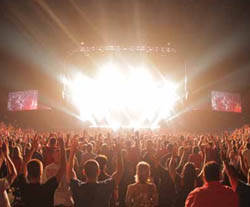
Focus On Playing
Returning now to meeting the band: “Ooh, that’s cool, how long have you played through that amp?” “What did you play through on the most recent album?” “Is there new gear in your setup?”
By asking them questions along these lines, I want to determine how set they are in their stage sounds. Are they happy and comfortable, or flexible and searching for some new solutions?
I don’t like to change the sound of a band on stage, what I want to do is stabilize it. I want to help them create an acoustic environment that works well for them so they can focus on playing the show instead of messing with the gear.
The next adventure is hanging out at some rehearsals. For me, this is the most important interaction. My mode is watching, listening, and wandering. I will stand near each of the players and hear what they hear when playing. For example, I’m more interested in the tone of the guitar amp where the guitar player stands than what is coming from the amp.
And, how similar are the instrument sounds to the recorded material? I make mental notes of any discrepancies and address them later with the artist. Do you prefer the sound on the album or the rehearsal sound? What about the vocal effects? Some album effects are nearly impossible to do live. How much focus should I put on emulating the backwards guitar solo?
Minimize The Changes
Also in evaluating rehearsals, I start building a mental picture of how I think the show should sound. Factors that are taken into account include: Is there a single person that is the driving force behind the band, or is it balanced between two or more members? Which instrument will reproduce the lowest frequencies? Will the kick sit tonally below or above the bass? Will vocal sibilance create breathy high frequencies above the cymbals?
In addition, there are many ways to overlay two guitars. There is the “wrap around” with one mid-range guitar and the other guitar with lower and higher totality and the mids scooped out a bit. There is the “high low” with a heavy chunky guitar and an edgy bright guitar that sort of combine to form a whole guitar sound. And then there is the “overlap’” with both sounding similar and relying on stereo panning and width to offer spatial differentiation. These also can be combined and altered based on the song or part of a song.
A big goal is trying to minimize the changes I actively need to make during a show so that the primary focus is on distilling several “sonic scenes” that suit particular songs or song tempos. Slow songs work well with extended low frequencies, crisper highs, and longer reverb times. Fast songs light up with a tighter kick and bass, as well as more snare bottom.
